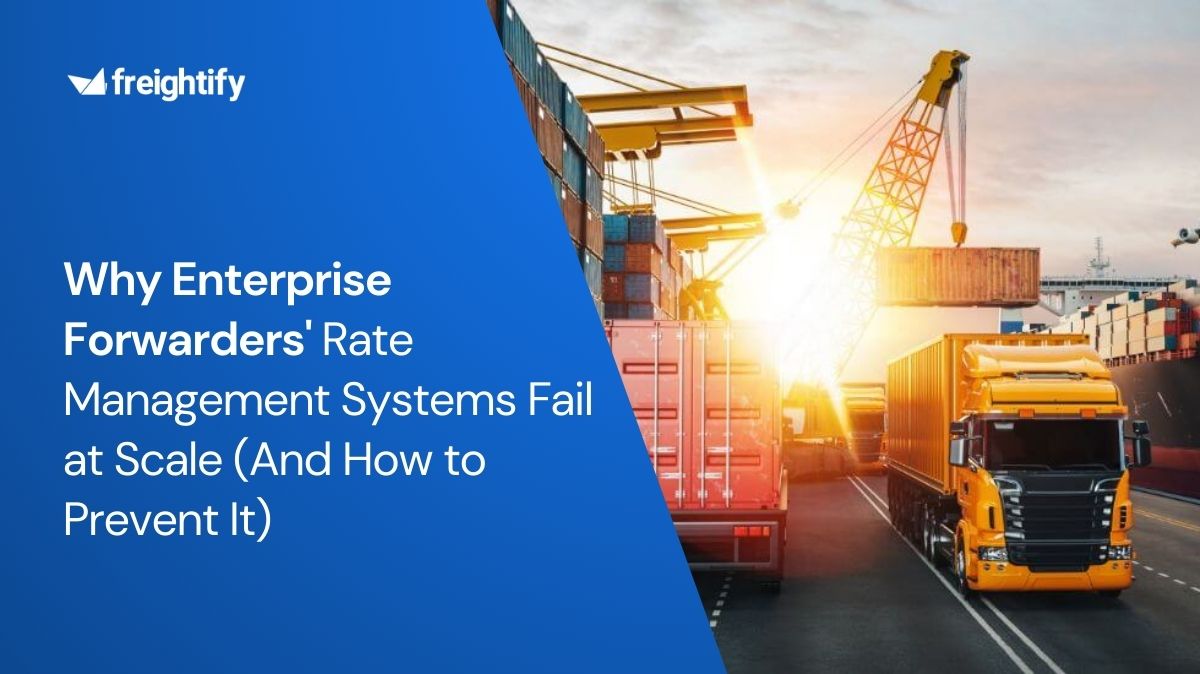The freight forwarding market is complex, requiring forwarders to coordinate with multiple carriers, customers, routes, and rates. The sheer volume of information that needs processing adds stress to supply chain operations, demanding resilient tech solutions to alleviate these challenges.
In a fast-paced industry, having access to accurate, real-time data is critical. Spot rates, quotes, schedules, and currency exchanges all significantly impact the bottom line. Gone are the days of manually tracking transactions on paper. Today, automated freight rate management systems (RMS) offer a streamlined approach to handling real-time data and insights.
This article explores how freight forwarders can build or integrate a robust RMS to stay competitive and why leveraging pre-built solutions like Freightify can be a game-changer.
What Makes an Effective Rate Management Solution (RMS)? An effective RMS must process substantial data volumes, provide accurate insights, and ensure visibility and transparency. The journey to creating an RMS can be divided into four key phases:
Generic Understanding Supplementary Facets Distinct Specifications Extensive Network Building Generic understanding for a rate management solution Before developing any software, it’s essential to understand the core problem it aims to solve. For an RMS, this means answering the following:
Who is affected by the problem? Why does it impact them? What solutions can improve the experience? The RMS tool should be more than an Excel list that keeps track of rates. This platform should eliminate time-consuming formulae and cumbersome processes. Standardizing formats and converting currencies at the daily exchange rates should be possible.
The rate management system must ensure that both the freight rates and appropriate schedules are covered, as well as the area of spot and daily price inquiries. Ultimately, the freight forwarders, agents, and their customers should benefit from the visibility and transparency that will be provided.
Supplementary facets for the RMS solution Once the brainstorming is completed, the solution’s feasibility should be explored. The expert developers, system architects, and manual testers must then design and program according to the code scripts written.
At this point, the RMS tool that is being constructed would need to be integrated into other software from which data (like carrier’s daily prices and exchange rates) will seamlessly flow in. The project team would also be required to classify the formats for data upload and information download.
In the quality assurance stage, the QA engineers will fix any bugs, after close examination. Focus groups will experiment with various versions of the software and provide their feedback.
And finally, just before releasing software, privacy concerns and security features need to be enhanced. The project team would need to make decisions like where to host the platform and devices to launch it on. A UX designer would also have to provide their inputs on how to make the tool user-friendly. This is imperative, as multiple types of profiles will access the rate management system simultaneously.
Distinct specifications for the rate management software A sophisticated RMS requires more than just the basics. It must include robust front-end and back-end functionalities:
Front-End The front-end serves as the user interface, allowing agents or customers to access rate information, compare prices, and request bookings.
Back-End The back-end handles the server, application, and database. It stores vast amounts of rate information from carriers, ensuring seamless functionality behind the scenes.
During the development phase, other common aspects that need to be brainstormed over are access management and authentication. The software may process accurate data. However, if the wrong people get their hands on this data, it will bring down the entire operation. Hence, decisions like how one accesses the tool to what kinds of editing rights does each person gets need to be decided up-front.
The service solution will require a diligently defined disaster recovery and response plan. Global trade will not stop just because the rate management system has suddenly crashed. Further, the project team should create problem management scopes and hierarchies to solve incidents.
As a stand-alone logistics company or as a freight forwarder, it will be very hard to take such major decisions without understanding the nuances involved. From determining which server to host the application on (either via own-premises or through Azure or AWS) to which concept is used for database management (blockchain or otherwise), the technical decisions are numerous. Freight forwarders would have to partner with technology consultants to make these verdicts, generate the scripts and create the front-end interface.
Extensive network building for the RMS Tool Having a great design and a perfect script would not suffice if the information that the database contains is not maintained efficiently. If a small or medium-scale freight forwarder was to create the RMS solution on their own, they would first have to approach all the carriers to identify the daily rates and the scheduled routes.
Post-pandemic, the freight market has shifted to a supplier-centric model. According to Freightify’s CEO, Raghavendran Viswanathan:
Previously, forwarders secured space first and then determined pricing. Today, space availability is uncertain, and forwarders struggle to quote prices confidently. However, in today’s supplier-centric market, the price has become the known devil for forwarders. The biggest problem a forwarder faces is finding freight space. And as a result, they need to know the price that will confirm the space for them. However, with global shipping trends, there’s no way to tell whether a price confirms a space commitment. That makes it difficult for them to give a price to their customers, and the cycle continues as customers would not know what they should be quoting for.
There are two ways to answer this tricky situation : one could either book a rate that has a confirmed booking attached to it; or, more effectively, use technology to gauge the rough price at which the cargo will win prized space on a carrier’s vessel.
In such a rate-driven market, the input rates and routes in the RMS tool will make or break a business. Hence, it is better to leave such a decisive activity with a seasoned supply chain technology provider. This will give freight forwarders more time to build their business and create a personal rapport with their clients.
Why reinvent the wheel? Many players make up the freight forwarding software market. However, the top 20 players dominate and account for more than 50% of the total market share. Digital forwarders must compete with established players as they invest in assets and customer service along with technology to enable more value-added services.
Additionally, high freight rates sustained forwarding revenue in 2020 and average margins were 7.5% . This makes the market more competitive with technology as the decisive factor.
Why re-invent the wheel when specialized tech providers in the supply chain industry (like Freightify ) have already done extensive analysis and research to develop a resilient RMS solution?
Why reach out to carriers and market authorities to get rates and routes?
Why worry about the technology costs of developing a new product when the available RMS tools can be customized?
Why traverse technical trials and teething troubles when proficient plug-and-play RMS solutions can be leveraged?
Freightify: The Shopify for Maritime Freight Freightify is a leader in digitalizing ocean freight rates. Here’s how we help freight forwarders:
Time Savings : Save 70% of time on rate management.Cost Reduction : Reduce operational costs by 50%.White-Labeled Solutions : Create custom customer-facing platforms.Integration : Connect with TMS and ERP systems for seamless data flow.Shipment Tracking : Monitor cargo movement in real-time.With Freightify, freight forwarders can set up online platforms where customers can:
Compare rates. Send quotes. Request bookings. Track shipments. Once freight forwarders set up an online platform with Freightify, their customers use it to compare rates, send quotes, request for booking, and track shipments. Take your first step towards digital rates and quotes. Try out our solutions at no cost now!




















